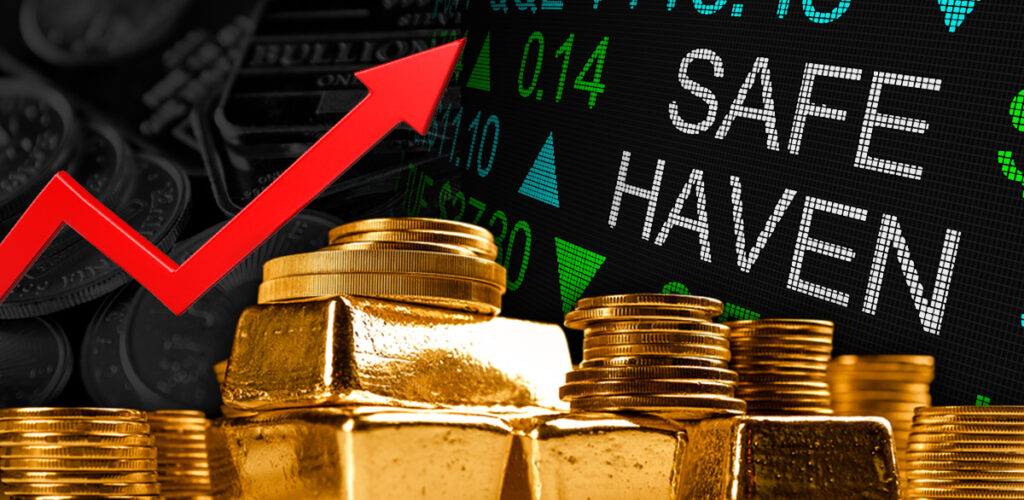 Safe haven assets are intended to protect investors during periods of prolonged economic downturn by maintaining their value despite market volatility. A safe haven asset differs from traditional investments in that they’re held with anticipation of a potentially weak economy. Knowing how to identify safe haven assets and incorporate these investments into a well-diversified portfolio can help preserve your wealth regardless of what economic uncertainty arises.
Safe haven assets are intended to protect investors during periods of prolonged economic downturn by maintaining their value despite market volatility. A safe haven asset differs from traditional investments in that they’re held with anticipation of a potentially weak economy. Knowing how to identify safe haven assets and incorporate these investments into a well-diversified portfolio can help preserve your wealth regardless of what economic uncertainty arises.
What are safe haven assets?
Safe haven assets are investment vehicles strategically chosen for their tendency to maintain or increase in value when instability dominates the economy. As the name suggests, these assets are intended to shelter an investor’s wealth from market volatility by counteracting the risk associated with traditional assets such as stocks.
Safe haven assets are indicative of a truly diversified portfolio wherein an investor is acknowledging the unpredictable and uncontrollable downturns in the market and preparing for potential losses accordingly. Effectively, these assets present yet another tool in the investor’s arsenal that serves more of a defensive strategy.
The goal of a safe haven asset isn’t to achieve massive, short-term gains. Instead, a safe haven asset is considered a success when it grows, breaks even, or even provides minimal loss, depending on the severity of economic pressures.
“You have the opportunity right now to buy physical gold, to back your own family’s security and your own future. It’s the smartest thing you could be doing right now as far as where to put your money. ”– Precious Metals Advisor Todd Graf
What are the features of a safe haven asset?
High liquidity
It’s common practice for investors to cycle in and out of safe haven assets based on the health of the economy for optimized returns. As a result, liquidity is a crucial characteristic of these protective investments. You want the flexibility to buy or sell a safe haven asset the minute market conditions and prices align with your goals.
Limited availability
Scarcity is a hallmark of safe haven assets. The lack of widespread availability ensures a certain level of value and protects against significant devaluation which could derive from a rapid change in supply. Generally, a boom in demand for a rare asset leads to upward price pressure, driving the value even higher for investors.
Price stability
As mentioned before, safe haven assets aren’t chosen for their promise of outsized gains. Alternatively, these investments are sought out because of their lack of volatility when compared to standard assets. Investments that maintain comparatively steady price action no matter what the economy churns out are indicative of secure investments.
Inflation hedge
In direct contrast to standard investments, safe haven assets tend to have an indirect relationship with traditional markets. In other words, when the stock market dips, these assets generally experience price jumps in direct opposition to the overall market trajectory. This is what investors mean when describing an asset as a hedge against inflation.
Historical precedence
A frightening amount of economic performance is determined solely by the whims of human psychology. That’s why safe haven assets have to prove their merit before earning a reputation as dependable, wealth-preserving instruments. Given that relatively high bar, only a handful of assets have achieved this status.
Global recognition and demand
The more recognizable and the greater the demand for a safe haven asset, the more stability it provides. The popularity of the investment vehicle shores up its value, especially during periods of economic downturn.
Limited economic dependence
Safe haven assets are less dependent on economic factors to maintain their value. Neither supply nor demand of the asset should drastically wax or wane depending on market indicators. This independence from the market’s performance is precisely what gives an asset its safe-haven qualities.
“Gold has always been the safety net. Despite all the rhetoric, [central banks] are still telling us that’s still true.”– Precious Metals Advisor John Karow
6 Safe Have Assets to Consider for Wealth Protection
1. Gold
Gold is by far the most well-established safe haven asset. For millennia, it’s been the cornerstone of human economies due to its proven track record of providing stability, security, and predictability. Even though the world abandoned the gold standard in the 1970s, central banks still maintain trillions worth of gold reserves and continue buying gold at record rates. Considering that the dollar has lost 99% of its value when compared to gold, the merit of this safe haven asset is clear. A key advantage of gold is its divisibility, allowing it to be transformed into various asset types such as bars, bullion, and coins and into various sizes.
2. Silver
Silver deserves more than to be viewed as gold’s less-popular cousin. In its own right, this safe haven asset has proven to be a good hedge against inflation. Silver’s widespread industrial use translates to steady demand, stable price action, and increased value. Plus, on a cost-per-ounce basis, silver is considerably more affordable than gold. The combination of a limited silver supply and increased green-energy demand makes for strong silver price forecasts. True diversification can be achieved by hedging your investment portfolio with both gold and silver.
👉 Related Read: Silver Price Forecast for 2025
3. Treasury Securities
Government bonds are debt securities sold by the federal government to increase its spending power. Treasury securities guarantee bondholders a certain ROI over a fixed period ranging from a week to several decades, depending on the type of bond issued. Securities might underperform traditional assets in the long run, but their backing by the US government provides stability and predictability. Recently, however, the federal failure of astronomical debt, political infighting, and de-dollarization has some people second-guessing the safety of bonds.
4. Consumer Staples Stocks
Consumer staple stocks are shares of businesses that produce or sell essential goods or services. Some common examples include companies that deal with healthcare, personal care, food and beverages, and household products. Also known as “defensive” stocks, these safe haven assets tend to retain their value through phases of economic turmoil as people still need to purchase essential items. It’s important to note that consumer staple stocks aren’t completely independent of market volatility which gives some investors pause when seeking out truly stable and secure assets.
5. Utility Stocks
Utility stocks are another popular safe haven asset that investors can access directly through the stock market. Generally, shares of companies that provide essential utilities such as telecommunications, water, natural gas, and electricity offer much more stability and security than their non-essential counterparts. Investors point to solid government oversight, high levels of regulation, and consistent demand as reasons for adding utility stocks to their portfolios.
6. Real Estate
Real estate is sometimes considered a safe haven asset depending on the risk tolerance and budget limitations of an investor. Similar to other inflation-hedge investments, real estate’s inherent value shields it from the ups and downs of mainstream assets. On top of that, investors have the potential to generate income from their residential or commercial investments. However, real estate is subject to unique considerations. These investments are difficult to unload due to their sheer size and price tags which makes it harder to liquidate your wealth. Furthermore, real estate has an incredibly lofty barrier of entry, eliminating most retail investors.
Considering Gold & Silver For Protection?
If you’re interested in learning more about investing in gold and silver, download our FREE Precious Metals Investment Guide. It covers everything you need to know about diversifying your portfolio with these safe haven assets to preserve your wealth.


